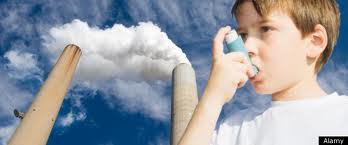Ozone and pollutants were the topics of two independent publications in October 2003, one in the New England Journal of Medicine (N Engl J Med) and the other in the Journal of the American Medical Association (JAMA).
Dr. Janneane F. Gent of Yale University School of Medicine in New Haven, Connecticut, and her team studied the effects of ozone and small pollutant particles on 271 cases of asthma in children less than 12 years of age (results published in the Oct. 8 ,2003 issue of JAMA). The researchers asked the question whether the air standards of the Environmental Protection Agency would be safe for asthmatic children. From spring 2001until now (about 2 years) exposure of air pollution was measured.
They found that in terms of particulate matter in the air the minimum standards were acceptable and no worsening of asthma took place because of flucutations in this component of air pollution (fine particulate matter of 2.5 micrometers or less). However, exposure to fluctuating ozone levels considered sofar to be safe were found to have profound effects in terms of worsening the asthma in the group of children being followed. For every 50 parts per billion (ppb) increase (in one hour ozone level) the wheezing of these astmatic children increased by 35% and chest tightness increased by 47%. At the time of the highest ozone exposure from a bad day of pollution, which was still “acceptable” to the standards of the Environmental Protection Agency, there was a 32% increase in shortness of breath and the children had to increase their medications by an average of 8% to cope with their asthma attacks (based on JAMA 2003;290:1859-1867,1915-1916).
A different facet of the asthma problem was dealt with in the Oct. 9, 2003 issue of the New England Journal of Medicine. Dr. Malcolm R. Sears from the McMaster University in Hamilton/Canada reported about a group of 613 children born in Dunedin/New Zealand in 1972 and 1973 who were followed with breathing tests and questionnaires until they reached the age of 26 years. This study showed that it does matter very much what lung irritants the very young asthmatic was exposed to and what lung irritants continue to affect the person later in life.
About half of the study population had at least one wheezing attack during the 26 years of observation. Contrary to popular belief asthma is not something “you grow out of” with age as 26.9% either had wheezing that persisited all the time (14.5%) or where the wheezing came back in adult life(12.4%). Allergies to house dust were associated with a risk of more than double and general airway hypersensitivity was associated with a triple risk of causing wheezing persistence or causing a return to wheezing. Other factors that were contributing to risk were female gender (1.7-fold risk) and exposure to cigarette smoke (1.8-fold risk). Those who started smoking young had the highest risk of asthma persistence and severity.
The more wheezing attacks there were and the more persistent the asthma was, the more permanently abnormal the lung function tests remained. The authors concluded that intervention against factors that lead to asthma must be initiated at a very young age. It is crucial to not allow environmental factors (ozone, pollution, allergens, cigarette smoke etc.) to interact with the asthma gene as this will lead to the more severe and chronic forms of asthma with permently abnormal lung function.
These two studies would reconfirm what the recent Swedish family lifestyle study had found as well. All of these studies point to the importance of the air quality and how the environment affects not only those with asthma, but affects everybody. Asthmatics simply are the tip of the iceberg due to a genetic weakness with which they were born. This makes asthmatics particularly vulnerable to pollution and to other environmental factors.
Link to a chapter on asthma from Dr. Schilling’s Net Health Book.
Last edited October 26, 2014






